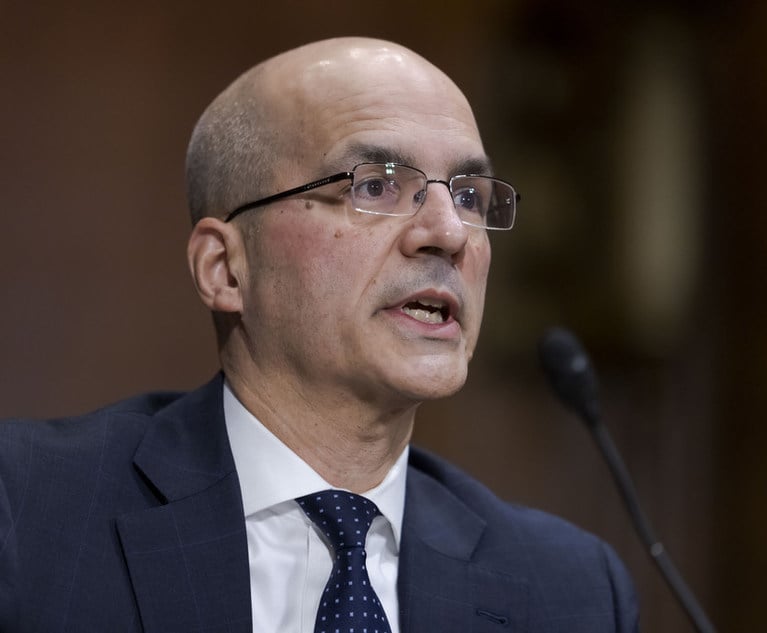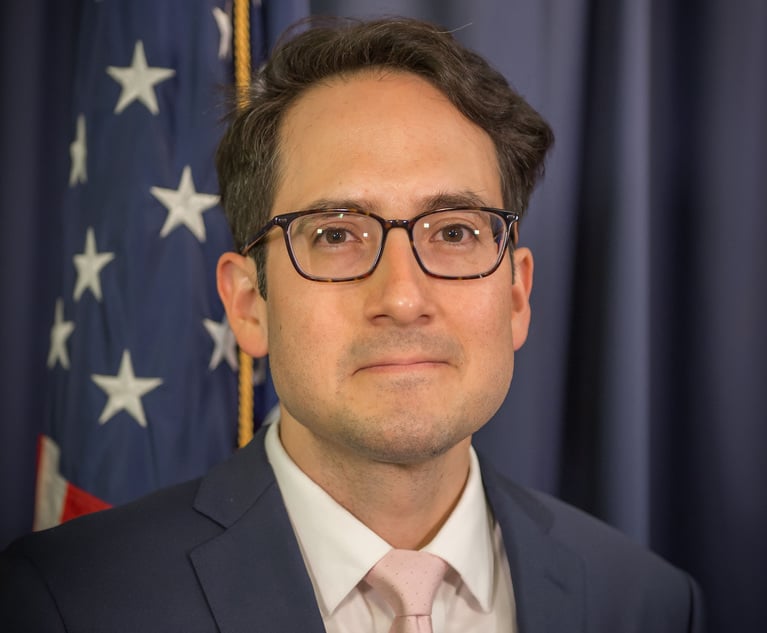'Twombly' Leaves Litigants Pleading for Clarification
In 2007, the Supreme Court decided Bell Atlantic v. Twombly, a once-controversial opinion that now needs no introduction. Twombly, as antitrust practitioners…
April 01, 2019 at 05:00 AM
5 minute read
 U.S. Supreme Court building in Washington, D.C.
U.S. Supreme Court building in Washington, D.C.
In 2007, the Supreme Court decided Bell Atlantic v. Twombly, a once-controversial opinion that now needs no introduction. Twombly, as antitrust practitioners well know, represented a seismic shift in the way antitrust cases were being pleaded, specifically requiring that an antitrust plaintiff plead enough "fact[s] to raise a reasonable expectation that discovery will reveal evidence of illegal agreement." (Fair enough.) Two years later, the Supreme Court clarified Twombly's broader application in Ashcroft v. Iqbal, holding that it was not limited to antitrust claims, but to all civil actions. (Simple enough.)
However, in recent years, practitioners have questioned the proper application and reach of Twombly. More specifically, it is indisputable that one of the original intents of Twombly was to minimize costs related to frivolous claims, but some question whether, in the name of Twombly, courts are now the ones spending too much time and resources—only to dismiss potentially viable claims. For example, in Big Baboon v. SAP America, a district court in California recently contemplated whether "you get to the point where we're wasting time and resources" when we "know what their claim is," and cautioned that courts shouldn't get "hung up" during the pleading stages due to Twombly. As others have expressed similar views, it is perhaps worth looking back at the landmark decision (which has been cited over 200,000 times since 2007), and asking whether there have, indeed, been some "hang-ups."
As even first-year law students know, the general pleading standard is governed by Rule 8(a) of the Federal Rules of Civil Procedure, which requires "a short and plain statement of the claim showing that the pleader is entitled to relief." For decades, antitrust defendants called for a stricter pleading standard, cautioning that frivolous antitrust complaints imposed significant costs on defendants, and even forced some into early settlements based on an analysis of defense costs, rather than the merits of the case itself. The Supreme Court seemed to address these concerns with Twombly, explaining that "it is one thing to be cautious before dismissing an antitrust complaint in advance of discovery, but quite another to forget that proceeding to antitrust discovery can be expensive."
The Court held that allegations at the pleadings stage must plausibly suggest an unlawful agreement, reflecting the "threshold requirement of Rule 8(a)(2) that the complaint's 'plain statement' possess[es] enough heft to 'show that the pleader is entitled to relief.'" While the Court discarded the idea that it was creating a heightened pleading standard for antitrust claims, and noted that it was not concerned with the specificity of the complaint, but rather with the plausibility of the claim itself, it was clear that an antitrust plaintiff could no longer survive a motion to dismiss relying on parallel conduct alone.
What perhaps wasn't so clear was how to properly analyze the "adequacy of the claim" and, consequentially, some courts have struggled with the proper application of the Twombly standard. It is, therefore, not surprising that inconsistent rulings on factually similar complaints plague the profession.
Some courts have even warned against using Twombly to apply a standard closer to that reserved for summary judgment. For example, in 2010, the Seventh Circuit acknowledged that "the contours of the Supreme Court's ruling [in Twombly], and particularly its application in the [antitrust] context, remain unclear," but at the complaint stage "the test for whether to dismiss a case … turns on the complaint's 'plausibility.'" In 2012, the Second Circuit clarified the proper application of Twombly's plausibility requirement, explaining that "[t]he question at the pleading stage is not whether there is a plausible alternative to the plaintiff's theory; the question is whether there are sufficient factual allegations to make the complaint's claim plausible."
In 2013, in Evergreen Partnering Group v. Pactiv, the First Circuit acknowledged the ongoing "considerable confusion" still being generated by Twombly, and emphasized that "heightened pleading requirements at the earliest stages of litigation would frustrate the purpose of antitrust legislation and the policies informing it." The court further noted that the "slow influx of unreasonably high pleading requirements at the earliest stages of antitrust litigation has in part resulted from citations to case law evaluating antitrust claims at the summary judgment and post-trial stages." Two years later, the Fourth Circuit agreed in SD3 v. Black & Decker that "[p]ost-Twombly appellate courts have often been called upon to correct district courts that mistakenly engaged in this sort of premature weighing exercise in antitrust cases." Moreover, that court explicitly cautioned that "courts must be careful not to import the summary-judgment standard into the motion-to-dismiss stage."
As Twombly approaches its 12th anniversary, the inconsistency surrounding it still leaves antitrust litigants struggling to understand its bounds. More importantly, where courts undertake a level of economic and factual analysis beyond which has been historically exercised at the pleading stage, one must wonder… at what expense? Such rigorous analysis at an early stage arguably runs contrary to Rule 8(a), especially because defendants are in possession of the facts underlying the claims and a plaintiff drafts the complaint without the benefit of discovery. Yet it remains equally important that courts continue to act as a gatekeeper barring frivolous claims, while allowing viable ones to pass. Twombly should, in theory, represent this balance, but the outcome of every individual case rests in the fateful hands of our federal courts.
Meegan Hollywood is a principal and Nahid Shaikh is an associate in Robins Kaplan's antitrust and trade regulation group. They prosecute antitrust actions involving price-fixing, unlawful monopolization, and other anti-competitive practices.
This content has been archived. It is available through our partners, LexisNexis® and Bloomberg Law.
To view this content, please continue to their sites.
Not a Lexis Subscriber?
Subscribe Now
Not a Bloomberg Law Subscriber?
Subscribe Now
NOT FOR REPRINT
© 2025 ALM Global, LLC, All Rights Reserved. Request academic re-use from www.copyright.com. All other uses, submit a request to [email protected]. For more information visit Asset & Logo Licensing.
You Might Like
View All
'Serious Legal Errors'?: Rival League May Appeal Following Dismissal of Soccer Antitrust Case
6 minute read
GOP Now Holds FTC Gavel, but Dems Signal They'll Be a Rowdy Minority
6 minute read

'A Warning Shot to Board Rooms': DOJ Decision to Fight $14B Tech Merger May Be Bad Omen for Industry
Trending Stories
- 1Carol-Lisa Phillips to Rise to Broward Chief Judge as Jack Tuter Weighs Next Move
- 2Data Breaches in UK Legal Sector Surge, According to ICO Data
- 3Georgia Law Schools Seeing 24% More Applicants This Year
- 4After Shutting USAID, Trump Eyes Department of Education, CFPB
- 5‘Keep Men Out’: Female Swimmers Sue Ivy Leagues Over Lia Thomas’ Sweep
Who Got The Work
J. Brugh Lower of Gibbons has entered an appearance for industrial equipment supplier Devco Corporation in a pending trademark infringement lawsuit. The suit, accusing the defendant of selling knock-off Graco products, was filed Dec. 18 in New Jersey District Court by Rivkin Radler on behalf of Graco Inc. and Graco Minnesota. The case, assigned to U.S. District Judge Zahid N. Quraishi, is 3:24-cv-11294, Graco Inc. et al v. Devco Corporation.
Who Got The Work
Rebecca Maller-Stein and Kent A. Yalowitz of Arnold & Porter Kaye Scholer have entered their appearances for Hanaco Venture Capital and its executives, Lior Prosor and David Frankel, in a pending securities lawsuit. The action, filed on Dec. 24 in New York Southern District Court by Zell, Aron & Co. on behalf of Goldeneye Advisors, accuses the defendants of negligently and fraudulently managing the plaintiff's $1 million investment. The case, assigned to U.S. District Judge Vernon S. Broderick, is 1:24-cv-09918, Goldeneye Advisors, LLC v. Hanaco Venture Capital, Ltd. et al.
Who Got The Work
Attorneys from A&O Shearman has stepped in as defense counsel for Toronto-Dominion Bank and other defendants in a pending securities class action. The suit, filed Dec. 11 in New York Southern District Court by Bleichmar Fonti & Auld, accuses the defendants of concealing the bank's 'pervasive' deficiencies in regards to its compliance with the Bank Secrecy Act and the quality of its anti-money laundering controls. The case, assigned to U.S. District Judge Arun Subramanian, is 1:24-cv-09445, Gonzalez v. The Toronto-Dominion Bank et al.
Who Got The Work
Crown Castle International, a Pennsylvania company providing shared communications infrastructure, has turned to Luke D. Wolf of Gordon Rees Scully Mansukhani to fend off a pending breach-of-contract lawsuit. The court action, filed Nov. 25 in Michigan Eastern District Court by Hooper Hathaway PC on behalf of The Town Residences LLC, accuses Crown Castle of failing to transfer approximately $30,000 in utility payments from T-Mobile in breach of a roof-top lease and assignment agreement. The case, assigned to U.S. District Judge Susan K. Declercq, is 2:24-cv-13131, The Town Residences LLC v. T-Mobile US, Inc. et al.
Who Got The Work
Wilfred P. Coronato and Daniel M. Schwartz of McCarter & English have stepped in as defense counsel to Electrolux Home Products Inc. in a pending product liability lawsuit. The court action, filed Nov. 26 in New York Eastern District Court by Poulos Lopiccolo PC and Nagel Rice LLP on behalf of David Stern, alleges that the defendant's refrigerators’ drawers and shelving repeatedly break and fall apart within months after purchase. The case, assigned to U.S. District Judge Joan M. Azrack, is 2:24-cv-08204, Stern v. Electrolux Home Products, Inc.
Featured Firms
Law Offices of Gary Martin Hays & Associates, P.C.
(470) 294-1674
Law Offices of Mark E. Salomone
(857) 444-6468
Smith & Hassler
(713) 739-1250








